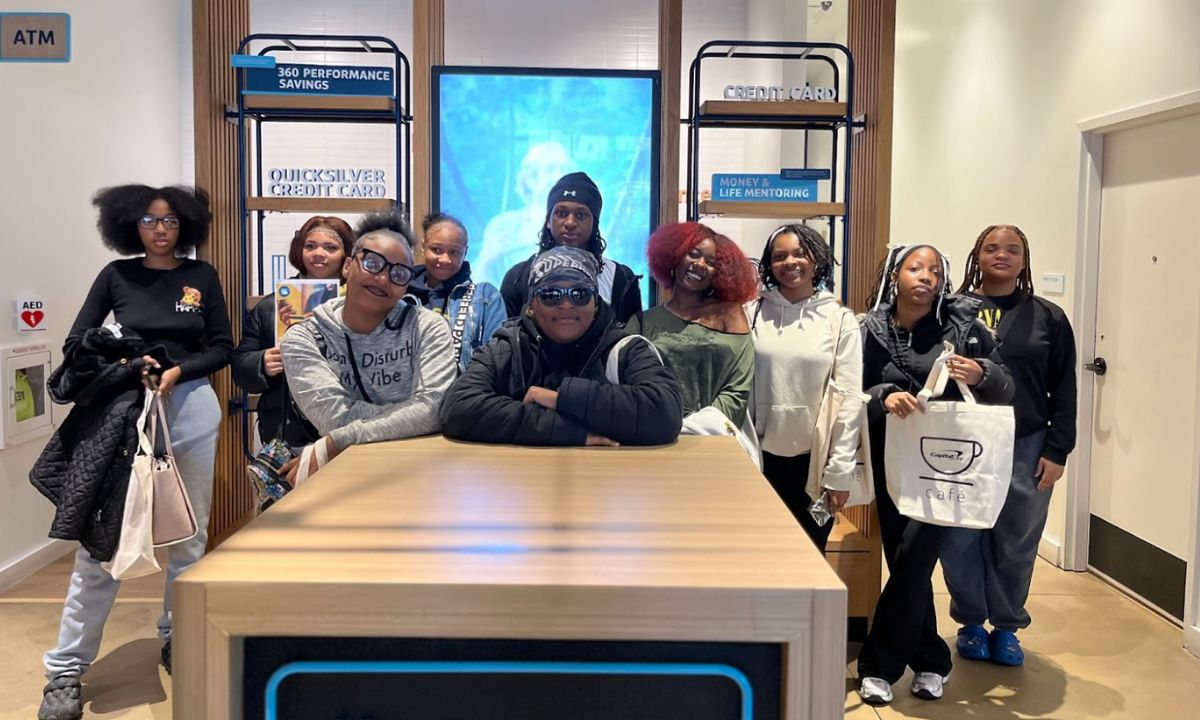To Tackle Chronic Absenteeism, This DC High School Lets Students Lead
With support from school leaders and XQ’s Design Principles, a student “pep squad” boosted attendance by strengthening students’ sense of belonging.

Get stories like this delivered straight to your inbox. Sign up for The 74 Newsletter
It was the last Friday before winter break at H.D. Woodson High School in the eastern corner of Washington, D.C. — historically one of the toughest days of the year for attendance. School team leads Rachel Curry-Neal and Ashlee Judon were eager to see how the day would play out.
Their colleagues and they had an ambitious goal: improve overall in-seat attendance rates by at least two percentage points. Like schools across the country, Woodson has struggled with high rates of chronic absenteeism. According to the D.C.’s Office of the State Superintendent of Education, nearly half of high schoolers missed school regularly during the 2023-2024 school year. Rates have improved since the worst days of the pandemic, but they remain stubbornly high, hovering around 40 percent across the nation’s capital.
Nationwide, the picture looks much the same, as disruptions from the pandemic, student mental health, socio-economic status, and chronic disengagement compound on one another to create a perfect storm of worsening attendance. These absences aren’t just about missing class. They’re predictors of whether students will graduate, pursue higher education, or find stable employment.
To address the problem, Curry-Neal, Woodson’s redesign director, and Judon, the school’s student experience coach, looked beyond conventional solutions — disciplinary threats and mandatory parent calls — and took a novel approach: letting students lead.
Woodson is part of DC+XQ, a partnership between XQ Institute and DC Public Schools (DCPS) to improve the high school experience through the implementation of XQ’s six, science-backed Design Principles that together lay the foundation for effective high school learning. One of these principles is youth voice and choice: creating authentic, regular opportunities for students to build agency and develop their identities. DCPS Chancellor Lewis D. Ferebee has been out front in linking attendance to students’ feelings of engagement and sense of belonging.
We know chronic absenteeism is anything but simple,” said Dr. Ferebee. “As part of DC+XQ, Woodson is enlisting the entire school community to help tackle this and other important challenges—and they’re leading with student voice. Our partnership with XQ is showing what’s possible when our young people have a seat at the table.”
In addressing chronic absenteeism, leaders at Woodson seized on the opportunity to bring students into the fold. Curry-Neal and Judon met with about 70 students eager to improve their high school experience and presented them with attendance metrics and Panorama data, which provides valuable insight for schools to monitor their students’ learning experiences. From those students, the school selected 10 mentors and charged them with leading a pilot program to boost attendance numbers.
Known as the Attendance Pep Squad, these 10 students gather every Tuesday at lunch to strategize. Their goal is twofold: first, identify students who might benefit from peer mentorship. And second, come up with creative ways to change the culture around attendance. During the fall semester, they developed an innovative outreach event — a playful, low-stakes peer networking gathering during which students exchanged stories and identified common experiences. Potential mentees also shared their schedules, academic interests, and any obstacles they were encountering, enabling mentors (along with Curry-Neal and Judon) to determine how best to pair students. About 22 students opted in to receive a peer mentor, and the program began in December of last year.
The Pep Squad also took steps to strengthen their fellow students’ sense of belonging. They organized a “Winter Spirit Week,” strategically timed for the week before winter break when attendance rates typically dip. They set up scavenger hunts, social activities and games, and a school-wide assembly to celebrate and close out the week.
The results exceeded expectations. In the 2023–24 school year, the Thursday before winter break had an attendance rate of just 42.6 percent. After the Pep Squad’s initiative, that number soared to 76 percent. Even the Friday before the break — one of the toughest days for any school to manage — recorded just under 60 percent.
“Students understand the barriers to attendance better than anyone,” said William Massey, Woodson’s principal. “We knew we’d be able to go further and faster with them in the driver’s seat.”
Not surprisingly, the students’ efforts also appear to be having a positive impact on achievement. After just one term, nearly half of mentees have improved their GPA, recovered credits required for graduation, or both. Several mentees also saw a decrease in the number of failed courses.
While Woodson isn’t declaring victory by any stretch, its early success suggests an alternative to conventional approaches, which often focus on imposing stiffer penalties on students who miss too much school. But these approaches don’t address root problems — and they can backfire if they erode positive relationships, alienate students, and put counterproductive burdens on school staff. In contrast, when students are afforded leadership opportunities that give them agency and voice, they feel like they belong and are eager to step up.
“It all coalesces into this magic alchemy,” Curry-Neal said.
That alchemy is backed by a growing body of data. Research shows that students who feel a strong sense of belonging not only have better attendance but also higher grades and fewer disciplinary problems than their disconnected peers. They also graduate at higher rates and are more likely to enroll in college. In their recent book The Disengaged Teen, authors Jenny Anderson and Rebecca Winthrop note that when students see school as boring, stressful, or pointless, their desire to show up evaporates.
Attendance alone doesn’t guarantee learning, but consistent presence is a crucial first step. “There’s a limit to how much we can learn if we’re not in the building,” Judon says.
Woodson has been intentional about building a community that students want to be part of. Panorama data show that the student experience has improved every year since Woodson began their redesign journey in the 2022-2023 school year. Today, Woodson ranks in the 90th percentile among urban districts for student sense of belonging. Curry-Neal traces this back to XQ’s Design Principles and its network of schools across the country, which enabled them to learn from earlier redesign efforts at Iowa BIG, Crosstown, and PSI High.
Woodson isn’t the only school whose redesign efforts are paying off. At PSI High in Florida, just 1 percent of students were chronically absent in 2023-24, compared to 25 percent for the broader district. At Design Works High School in New York, 10 percent of students were chronically absent in 2023-24, compared to 47 percent for NYC high schools on average.
There are no silver bullets when it comes to the very complex problem of chronic absenteeism, but it’s increasingly clear that making students feel like they are part of the solution is a step in the right direction.
“It’s complicated,” Curry-Neal admits. “A pep squad, text messages, walking kids to school—that only works if the rest of the school environment supports it. But right now, we’re seeing that when students feel they belong here, they want to come back. And that’s half the battle.”
This article was published with the support of XQ Institute.
Want to learn more about how to create innovative teaching and learning in high schools? Subscribe to the XQ Xtra, a newsletter that comes out twice a month for high school teachers.
Disclosure: The XQ Institute is a financial supporter of The 74.
Get stories like these delivered straight to your inbox. Sign up for The 74 Newsletter

;)